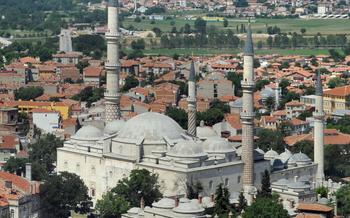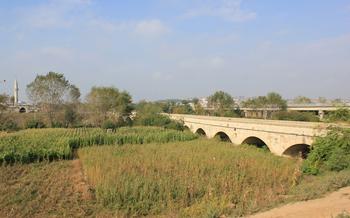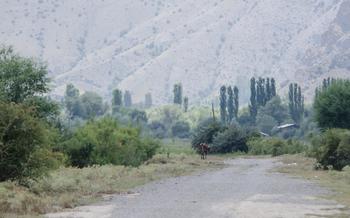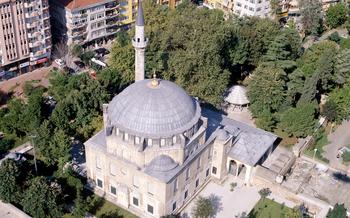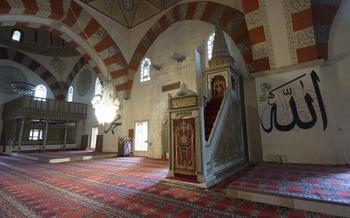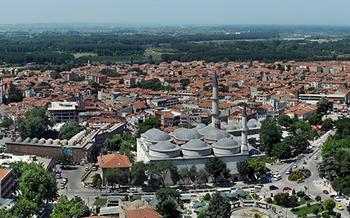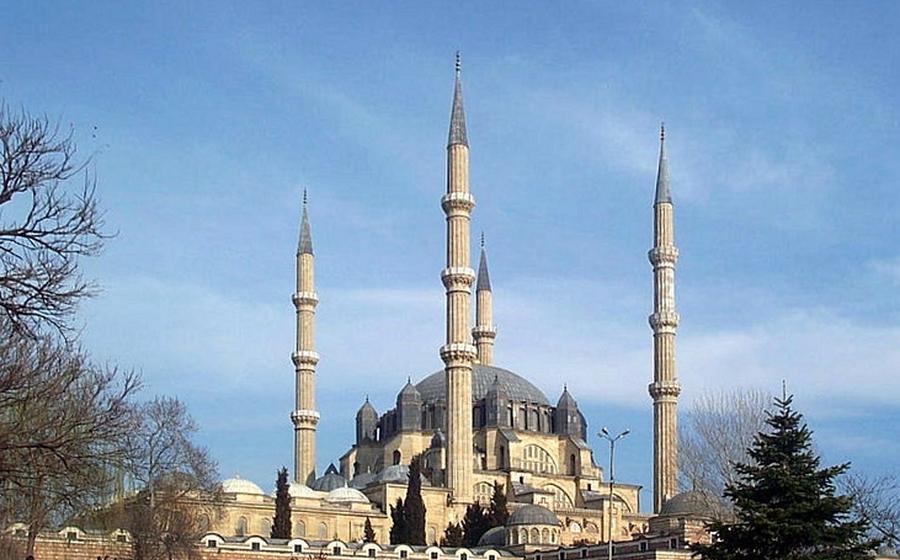
Dar'ül Hadis Camii
- Dar'ül Hadis Camii: A Historic and Architectural Masterpiece
- History: A Legacy of Faith and Devotion
- Architecture: A Symphony of Design and Detail
- Interior: A Realm of Serenity and Grandeur
- Exploring the Grounds: A Serene Retreat
- The Story of Dar'ül Hadis Camii: A Journey Through Time
- Immerse in the Islamic Heritage: A Cultural Tapestry
- A Place of Worship and Reflection
- The Legacy of Mimar Sinan: A Master Architect
- A Haven for History Enthusiasts
- Experience the Local Culture: A Vibrant Tapestry
- Tips for a Meaningful Visit
- Plan Your Visit: Essential Information
- Capture the Beauty: Photography Tips
- Solo Travel: A Unique Experience
- Family-Friendly Activities: A Memorable Outing
- Insider Tip: Unveiling Hidden Charms
Dar'ül Hadis Camii: A Historic and Architectural Masterpiece
The Dar'ül Hadis Camii stands as a testament to the rich history and architectural prowess of Edirne. Built in the 16th century during the reign of Sultan Selim II, the mosque holds immense significance as one of the finest examples of Ottoman architecture. Its intricate design, captivating interior, and cultural importance make it a must-visit destination for any traveler seeking to immerse themselves in the wonders of Islamic architecture and history.
History: A Legacy of Faith and Devotion
The foundation of the Dar'ül Hadis Camii can be traced back to the vision of Sultan Selim II, who sought to create a place of worship and learning that would serve as a center of Islamic education and spiritual guidance. The mosque was constructed under the supervision of the renowned architect Mimar Sinan, who skillfully blended traditional Ottoman elements with innovative design techniques to create a masterpiece that would stand the test of time.
Architecture: A Symphony of Design and Detail
The Dar'ül Hadis Camii showcases a harmonious blend of architectural styles, reflecting the diverse influences that shaped Ottoman architecture. Its imposing dome, graceful minarets, and intricate tilework create a visually stunning ensemble that captivates the eyes. The interior of the mosque is equally impressive, adorned with intricate calligraphy, vibrant stained glass windows, and elegant chandeliers that illuminate the vast prayer hall.
Interior: A Realm of Serenity and Grandeur
Step inside the Dar'ül Hadis Camii, and you will be transported to a realm of tranquility and awe. The spacious prayer hall, with its soaring arches and elegant columns, creates a sense of serenity that invites contemplation and reflection. The mihrab, the niche indicating the direction of Mecca, is adorned with exquisite tilework and calligraphy, drawing the eyes of worshippers towards the sacred Kaaba. The minbar, from which the imam delivers sermons, is a masterpiece of craftsmanship, showcasing intricate carvings and inlaid mother-of-pearl.
Exploring the Grounds: A Serene Retreat
Venturing beyond the Dar'ül Hadis Camii's awe-inspiring exterior reveals a tranquil oasis, where nature seamlessly blends with architectural brilliance. Wander through the meticulously manicured gardens, where colorful blooms, fragrant flowers, and towering trees create a picturesque tapestry. Inhale the intoxicating scents of jasmine, lavender, and roses as you stroll along the winding paths, leading you to hidden corners and secluded spots.
Admire the serene courtyard, designed to evoke a sense of tranquility and serenity. Its symmetrical layout, with its central fountain surrounded by intricate tilework and geometric patterns, invites contemplation and reflection. The gentle splashing of water from the fountain adds a soothing melody to the tranquil atmosphere, creating a sanctuary for weary souls.
Listen to the soothing sounds of the water fountains, strategically placed throughout the grounds. Their gentle flow and rhythmic melodies add a touch of tranquility to the surroundings, inviting visitors to pause and appreciate the simple beauty of nature.
Observe the traditional ablution area, an essential element of Islamic architecture. This designated space, located near the entrance of the mosque, allows worshippers to perform the ritual purification before entering the prayer hall. The ablution area features rows of taps and basins, each adorned with intricate designs and patterns, reflecting the importance of cleanliness and purity in Islamic tradition.
The Story of Dar'ül Hadis Camii: A Journey Through Time
The establishment of the Dar'ül Hadis Camii can be traced back to the reign of Sultan Murad II, who desired a mosque dedicated to Islamic education and scholarship. The construction began in 1438 under the supervision of Mimar Sinan, the renowned Ottoman architect. The mosque's strategic location in Edirne, the capital of the Ottoman Empire at the time, reflected its importance as a center of Islamic learning.
The construction of the Dar'ül Hadis Camii was a remarkable feat of engineering and craftsmanship. Mimar Sinan employed innovative techniques and incorporated elements from both traditional Islamic architecture and Byzantine influences. The mosque's grand dome, intricate tilework, and elegant minarets showcased the architectural prowess of the Ottoman Empire.
Over the centuries, the Dar'ül Hadis Camii underwent several renovations and restorations to maintain its grandeur. In the 16th century, Sultan Suleiman the Magnificent ordered extensive renovations, including the addition of a new courtyard and a fountain. In the 19th century, the mosque was damaged by an earthquake and subsequently restored by Sultan Abdulmejid I.
Today, the Dar'ül Hadis Camii stands as a testament to the enduring legacy of Mimar Sinan and the commitment of the Ottoman sultans to Islamic education. Its ongoing preservation efforts ensure that this architectural masterpiece continues to inspire and captivate visitors from around the world.
Immerse in the Islamic Heritage: A Cultural Tapestry
The Dar'ül Hadis Camii stands as a testament to the rich Islamic heritage that permeates Turkey. As you step inside the mosque, you'll be captivated by the exquisite Islamic art that adorns every corner. From the intricate calligraphy that graces the walls to the vibrant tilework that covers the floors, each element reflects the artistry and devotion of the Muslim community.
The mosque's religious significance is palpable. It serves as a center for Islamic education, where students gather to study the Quran and Islamic law. During prayer times, the mosque's spacious prayer hall fills with worshippers, creating a sense of unity and devotion. The ornate mihrab, indicating the direction of Mecca, guides worshippers during their prayers, while the melodic recitation of the Quran echoes through the mosque's walls, filling the air with a sense of serenity.
The Dar'ül Hadis Camii embodies the Islamic beliefs and traditions that have shaped Turkish culture. It represents a place where Muslims can come together to worship, learn, and connect with their faith. The mosque also serves as a symbol of cultural exchange, fostering understanding and dialogue between different cultures and religions.
A Place of Worship and Reflection
Step inside the majestic prayer hall of the Dar'ül Hadis Camii, where worshippers gather for daily prayers, seeking solace and spiritual connection. Admire the intricate designs and motifs adorning the walls and ceiling, creating a serene atmosphere conducive to contemplation. Gaze upon the ornate mihrab, a niche indicating the direction of Mecca, guiding worshippers during their prayers. Learn about the significance of the minbar, a raised platform used by the imam to deliver sermons and religious teachings, spreading knowledge and guidance among the faithful. Listen to the melodious recitation of the Quran, echoing within the mosque's walls, filling the air with a sense of devotion and tranquility. Experience the profound spirituality that permeates the Dar'ül Hadis Camii, a place where worshippers find solace, guidance, and a connection to the divine.
The Legacy of Mimar Sinan: A Master Architect
The Dar'ül Hadis Camii stands as a testament to the genius of Mimar Sinan, one of the most renowned architects in Islamic history. Sinan's innovative designs and mastery of symmetry and harmony are evident throughout the mosque's layout and structure. He pushed the boundaries of mosque architecture, creating a building that is both aesthetically pleasing and functionally efficient.
Sinan's innovative use of domes and arches allowed him to create a vast interior space that is both awe-inspiring and conducive to prayer. The mosque's exterior is equally impressive, with its elegant minarets and intricate tilework. Sinan's attention to detail is evident in every aspect of the mosque, from the delicate calligraphy on the walls to the intricate carvings on the mihrab.
The Dar'ül Hadis Camii is a masterpiece of Islamic architecture and a testament to the skill and creativity of Mimar Sinan. His enduring legacy continues to inspire architects and designers around the world.
A Haven for History Enthusiasts
The Dar'ül Hadis Camii stands as a testament to the rich history of Edirne and the enduring legacy of the Ottoman Empire. Delve into the historical events and figures associated with this magnificent mosque, exploring its connection to the empire's architectural prowess and cultural heritage. Discover the mosque's role in preserving and transmitting Turkish cultural traditions, showcasing the enduring spirit of a nation. Witness the mosque's ability to withstand the test of time, enduring through various historical periods, serving as a symbol of resilience and continuity.
Experience the Local Culture: A Vibrant Tapestry
Immerse yourself in the vibrant local culture that surrounds the Dar'ül Hadis Camii. Engage with the friendly locals, who are renowned for their warm hospitality and willingness to share their traditions. Participate in local festivals and celebrations that showcase the rich cultural heritage of Edirne. Don't miss the opportunity to savor the delicious local cuisine, which offers a tantalizing array of traditional dishes and flavors. Embrace the community spirit and feel the genuine warmth and welcoming nature of the people who call this city home.
Tips for a Meaningful Visit
Visiting the Dar'ül Hadis Camii is a profound experience that requires respect and understanding of local customs and etiquette. Show your reverence by dressing modestly, covering your shoulders and knees. Remember to remove your shoes before entering the prayer hall, and maintain a respectful silence throughout your visit. Photography is generally allowed, but always ask permission before taking pictures of people or sensitive areas. To fully grasp the mosque's significance, consider joining a guided tour led by knowledgeable locals who can provide insights into its history, architecture, and cultural importance. Embracing these guidelines will ensure a meaningful and enriching visit to this sacred site.
Plan Your Visit: Essential Information
To make your visit to the Dar'ül Hadis Camii seamless and enjoyable, planning is key. The mosque is conveniently located in the city center, ensuring easy access by foot or public transportation. Check the mosque's website or contact local tourism offices for specific directions and transportation options.
Operating hours vary depending on the time of year and religious observances. It's advisable to visit during regular prayer times to witness the mosque's vibrant spiritual atmosphere. However, remember to be respectful and observe proper etiquette while inside the prayer hall.
Admission to the Dar'ül Hadis Camii is generally free of charge. However, donations are welcome and contribute to the mosque's upkeep and preservation. Consider leaving a small donation to support this historic landmark.
For visitors with disabilities or special needs, the mosque provides wheelchair access and designated areas for prayer. Please inquire with the mosque's administration or local tourism offices for further assistance.
Capture the Beauty: Photography Tips
The Dar'ül Hadis Camii offers a treasure trove of photographic opportunities, capturing its architectural grandeur and intricate details. To make the most of your photography experience:
-
Embrace Natural Lighting: Time your visit to take advantage of the warm, golden light of sunrise or sunset, which casts a magical glow on the mosque's exterior.
-
Experiment with Angles: Explore different angles to showcase the mosque's imposing presence and capture unique perspectives that reveal its hidden beauty.
-
Focus on Details: Zoom in on the intricate tilework, calligraphy inscriptions, and decorative elements that adorn the mosque, creating striking close-up shots.
-
Compose Your Shots: Pay attention to composition, ensuring that the mosque's grandeur is the focal point while incorporating elements of the surrounding environment for added depth.
Solo Travel: A Unique Experience
Embark on a journey of self-discovery as you explore the Dar'ül Hadis Camii as a solo traveler. Edirne, a city steeped in history and culture, welcomes solo travelers with open arms. Experience the warmth and hospitality of the locals as you navigate the city's streets and immerse yourself in the vibrant atmosphere.
Feel safe and secure as you wander through the city, known for its low crime rates and friendly residents. Engage in meaningful conversations with locals and fellow travelers, creating lasting connections and gaining unique perspectives. Embrace the opportunity for self-reflection and personal growth as you explore the mosque's tranquil spaces and contemplate its rich history.
Enjoy the flexibility of solo travel, allowing you to set your own pace and delve deeper into the mosque's intricate details. Discover hidden corners and uncover stories that may go unnoticed by larger groups. Savor the freedom to wander aimlessly, allowing serendipitous encounters to shape your experience.
Family-Friendly Activities: A Memorable Outing
The Dar'ül Hadis Camii is not just a historical and architectural gem; it also offers a rich and engaging experience for families.
-
Kid-Friendly Tours: Look for guided tours designed specifically for families. These tours often use storytelling and interactive activities to bring history to life for young minds.
-
Educational Opportunities: Turn your visit into a learning experience. Teach your children about Islamic architecture, the history of the Ottoman Empire, and the significance of religious practices.
-
Fun Activities: Plan activities that make learning fun. Organize a scavenger hunt around the mosque, have kids draw or paint their impressions of the architecture, or play games that reinforce what they've learned.
-
Create Lasting Memories: Capture your family's adventure with photos and videos. The Dar'ül Hadis Camii provides a stunning backdrop for family portraits and group shots.
Insider Tip: Unveiling Hidden Charms
Discover the hidden garden nestled within the mosque complex, a tranquil oasis away from the city's hustle and bustle. Ascend to the rooftop to capture breathtaking panoramic views of Edirne and its surroundings, a vista that will leave you spellbound. Indulge in traditional Turkish sweets and snacks from nearby shops, tantalizing your taste buds with local flavors. To escape the crowds and experience a more intimate ambiance, plan your visit during the shoulder season (spring or fall), when the city exudes a unique charm.


